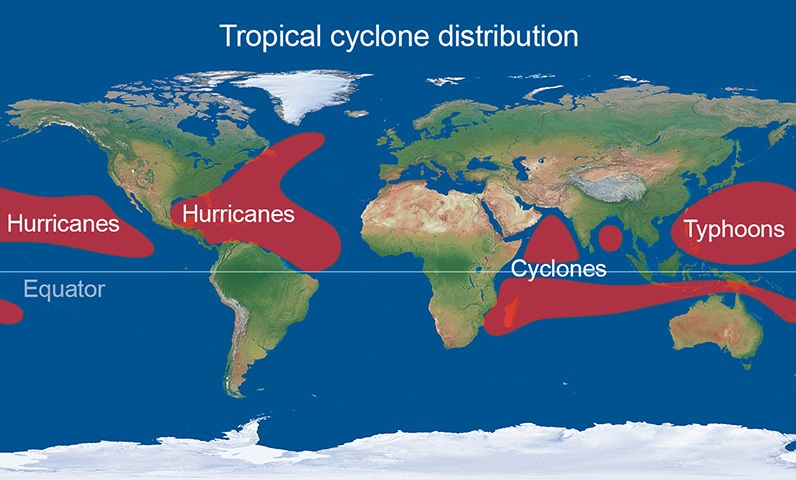Tropical Cyclone
What is a Tropical Cyclone?
- A tropical cyclone is a rapidly rotating storm that begins over tropical oceans, and they can vary in speed, size, and intensity.
- Tropical cyclones are also called hurricanes or typhoons, depending on the region.
- According to the World Meteorological Organisation (WMO), Tropical cyclones are the second-most dangerous natural hazards, after earthquakes.
Conditions for the formation of Tropical Cyclone
- A source of warm, moist air derived from tropical oceans with sea surface temperatures normally in the region of, or in excess, of 27 °C;
- Winds near the ocean surface blowing from different directions converging and causing air to rise and storm clouds to form;
- Winds which do not vary greatly with height – known as low wind shear. This allows the storm clouds to rise vertically to high levels;
- Sufficient distance from the equator to provide spin or twist.
How do tropical cyclones form?
- In the tropics there is a broad zone of low pressure which forms due to high temperature which stretches either side of the equator.
- Within this area of low pressure the air is heated over the warm tropical ocean. This air rises in discrete parcels, causing thundery showers to form.
- The winds on the north side of this zone blow from the north-east (the north-east trades) and on the southern side blow from the south-east (south-east trades) and start to converge at the low pressure system.
- The Coriolis force caused by the rotation of the Earth helps the spin of this column of rising air.
- As the depression strengthens it becomes a tropical storm and then a hurricane or typhoon.
- A mature hurricane or typhoon takes the form of a cylinder of deep thunderclouds around a centre that is relatively free from clouds.
- At the centre of the tropical cyclone, air is subsiding, which makes it dry and often cloud free, and there is little or no wind at the surface. This is called the eye of the storm.

How does the Tropical Cyclone obtain its energy?
- Great amounts of energy are transferred when warm water is evaporated from tropical seas.
- This energy is stored within the water vapour contained in moist air.
- As this air ascends, 90% of the stored energy is released by condensation. The release of heat energy warms the air locally, causing a further decrease in pressure aloft.
- Consequently, air rises faster to fill this area of low pressure, and more warm, moist air is drawn off the sea, feeding further energy to the system. Thus, a self-sustaining heat engine is created.
Distribution of Tropical Cyclones

Why in News?
- The severe cyclonic storm Remal made its landfall process between Sagar Island in West Bengal and Khepupara in Bangladesh.
Subscribe
Login
0 Comments
